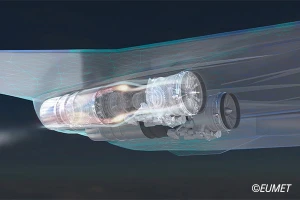innovation
“We put innovation on the fast track”
Dr. Carsten Subel, Head of the Inno Lab at MTU, on the global search for technology trends and the significance of a company culture that lets innovation thrive.
author: Thorsten Rienth | 5 mins reading time published on: 01.03.2020
author:
Thorsten Rienth
writes as a freelance journalist for AEROREPORT. In addition to the aerospace industry, his technical writing focuses on rail traffic and the transportation industry.

Mr. Subel, MTU is renowned the world over for its advanced engine technology. Why does the company need an independent Inno Lab?
Dr. Carsten Subel: MTU is a creative and innovative company. Our development engineers have been pushing the technology envelope for decades and are plugged in to an excellent network of universities and research institutions. The Inno Lab doesn’t compete with any of our development departments. Rather, it expands our capacity for innovation by keeping an eye on processes, product improvements and new services and business models. It is another way for us to fast track ideas in house. Our slogan says it all: “new ideas quickly prototyped.” But it’s not just about ideas, it’s also about innovation. The only way an idea can become an innovation is if customers like it and it catches on. Prototyping allows us to discover whether the demand is really there for a new product or idea. Speed is our competitive edge.
Is the Inno Lab set up more for in-house or external customers?
Subel: Our focus is largely in-house. We don’t act as a service provider for external customers. We make sure that MTU takes up new topics. Our three basic goals are to search for trends, generate ideas and promote a company culture that lets innovation thrive.
Inno Lab: Offering the space to bring skills together
Plenty of room for ideas: MTU’s Inno Lab is not located directly on the premises of the Munich site, but is adjacent to it. In its bright rooms, everything is set up to promote creative work. A cosy kitchen serves as an area for socializing. The pitching area offers a small audience stand and a stage on which to present new concepts. And there is an area housing a 3D printer on which to produce prototypes.
Is it really possible to generate ideas?
Subel: Yes, and in all sorts of different ways! Each and every MTU employee can submit ideas to us whenever they want. A few weeks ago, the Inno Lab held an open call for ideas. Lots of MTU employees submitted ideas and pitched them in person. The spectrum of proposals was enormous, ranging from specific product designs like a bionic heat exchanger to a new lighting concept promoting employee wellbeing and even improved communication processes based on interactive digital platforms. Sometimes, ideas can emerge from a series of face-to-face conversations. In the past few months, for instance, we’ve noticed there’s a topic that colleagues from across different business areas are already working on because they can see it has huge potential: machine vision.
What’s that about?
Subel: Machine vision is essentially about carrying out tasks with the aid of a computer in a way that takes its cue from humans’ ability to see—and then act. Put simply, these are camera-computer systems that can identify deviations in material quality or automatically record components following disassembly. It’s a branch of artificial intelligence. We’ve realized that MTU performs countless tasks that could benefit from the application of machine vision. And there are quite a few colleagues out there who are clued up about this technology and who we can now bring together. Basically, this topic was destined to be championed by the Inno Lab as an innovation accelerator.
”We start in the Inno Lab by selecting a technology with potential; then we determine specific areas of application for it at MTU.“
Artificial intelligence is undoubtedly one of today’s most exciting topics. You mentioned that you also do a bit of trend scouting in the Inno Lab. Why is that so important?
Subel: On the face of it, scouting is about us being attentive and not letting any technological developments pass us by that others are already successfully employing. In addition to that, we aim to identify emerging technology trends early on. To that end, we tap into new resources. For example, we hunt for conspicuous recent spikes in patent applications in particular areas. We also take a look at what start-up companies are up to. And we conduct web analyses to note the trends motivating companies and people around the world as a way to identify megatrends, like mobility and connectivity, and find ways to make them work for us. In 2019, many trends revolved around human-machine interaction. We know we’re moving in the right direction whenever we identify a trend we were already aware of, and when we do find one that had slipped past us, we immediately pick up on it. We start in the Inno Lab by selecting a technology with potential; then we determine specific areas of application for it at MTU. In the case of machine vision, we also contacted some start-ups and got them on board to help us develop it, and now we’re working together on prototypes.
And this type of cooperation fosters the creative company culture you have set out to achieve?
Subel: Exactly. It’s all about always creating a bridge between the problem and the solution. Not everyone who comes to us has an idea. Colleagues who make us aware of problems are just as valuable to us. People who have developed a sense of innovation can come up with brand new ideas simply by talking to other people—even quite by chance, say over lunch.
Have you ever experienced that?
Subel: Recently, two colleagues were sitting together in the cafeteria. One of them was talking about his hobby as an astrophotographer and how difficult it was to take a photograph of two bright stars against a dark background because the light sources outshine each other. The other guy told him that he knew how to solve the problem because he had some filter software that he could use to reduce overexposure. This piqued the first colleague’s interest because it reminded him of a work-related issue where imperfections on reflective and shiny turbine blades are difficult to spot during optical quality inspections. The two colleagues then approached us at the Inno Lab with the idea of using this technology at MTU.







